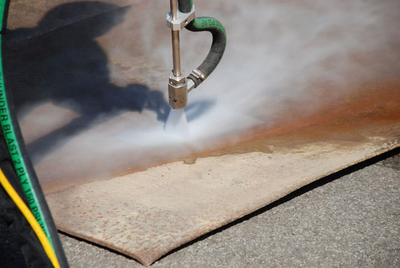7th Aug 2024
Sandblasting (a term outdated in the UK and that is now better known as abrasive blasting), is the process of propelling fine particles at high velocity to clean, smooth, or shape surfaces, and has become a pivotal technique across numerous industries. From aerospace to construction, the applications and advantages of sandblasting are vast and varied.
In this blog, we aim to elucidate the multifaceted uses of sandblasting, providing in-depth insights into its transformative effects. We will discuss the various types of sandblasting media, essential safety protocols, and detailed guides to mastering this powerful technique. Our goal is to offer valuable information that will enhance your understanding and application of sandblasting, showcasing why it has become an indispensable tool in both professional and personal projects.
What is sandblasting?
Sandblasting, a technique involving the high-velocity propulsion of abrasive materials onto surfaces, has become a cornerstone in various industries due to its versatility and effectiveness. This method is employed for a multitude of purposes, from surface preparation and cleaning to etching and shaping.
What are the advantages of using sandblasting?
- Sandblasting is highly effective in removing rust, paint, scale, and other contaminants from surfaces, leaving them clean and ready for further processing or finishing. This method is particularly useful for preparing metal surfaces for subsequent treatments like painting, coating, or bonding. The thorough cleaning ensures that all unwanted materials are eliminated, creating an optimal base for the next steps in the manufacturing or finishing process.
- Before applying coatings like paint or powder coating, sandblasting ensures the surface is adequately roughened to enhance adhesion, also known as an anchor pattern. This is crucial for the longevity and durability of the coating. A properly roughened surface allows the coating to bond more effectively, which helps prevent peeling, chipping, and other forms of deterioration over time, thereby maintaining the integrity and appearance of the finished product.
- In manufacturing, especially in metalworking and machining, sandblasting is used to remove burrs (small, unwanted pieces of material) from edges and surfaces of components. This results in smoother finishes and improved functionality. By eliminating these imperfections, sandblasting not only enhances the aesthetic quality of the components but also improves their mechanical performance and ease of assembly.
- Sandblasting can create specific textures or patterns on surfaces, which is useful for decorative purposes. This capability allows manufacturers with the flexibility to achieve unique visual and tactile effects. Whether for architectural elements, consumer products, or artistic creations, sandblasting can enhance the overall appeal and differentiation of the final product.
- By using different types of abrasive materials, sandblasting can smooth and polish surfaces, enhancing their appearance and tactile feel. This technique is often employed in industries such as automotive and aerospace, where both aesthetics and performance are paramount. The ability to achieve a polished, smooth finish can improve not only the visual appeal but also the aerodynamic properties of the components.
- Regular sandblasting maintenance helps extend the life of machinery and structures by preventing the buildup of rust and other corrosive elements. By routinely removing these potentially damaging substances, sandblasting helps to preserve the structural integrity and performance of equipment and infrastructure, ultimately reducing maintenance costs and downtime.
- In precision industries, like aerospace and electronics, sandblasting can be used to prepare surfaces for delicate operations such as bonding or to clean intricate components without causing damage. The precision and control offered by sandblasting make it an ideal solution for these high-stakes environments, where even the smallest imperfections can lead to significant issues. This careful preparation ensures that components meet the exacting standards required for their intended applications.
In conclusion, the utility and effectiveness of sandblasting make it an indispensable technique across a wide range of industries. Its ability to prepare, clean, shape, and prolong the life of surfaces with unparalleled precision and efficiency underscores its value. As industries continue to evolve and demand higher standards of quality and performance, sandblasting will undoubtedly remain a vital tool in achieving these goals. Through continuous innovation and adherence to best practices, the potential applications and benefits of sandblasting will only expand, driving progress and excellence in various fields.




